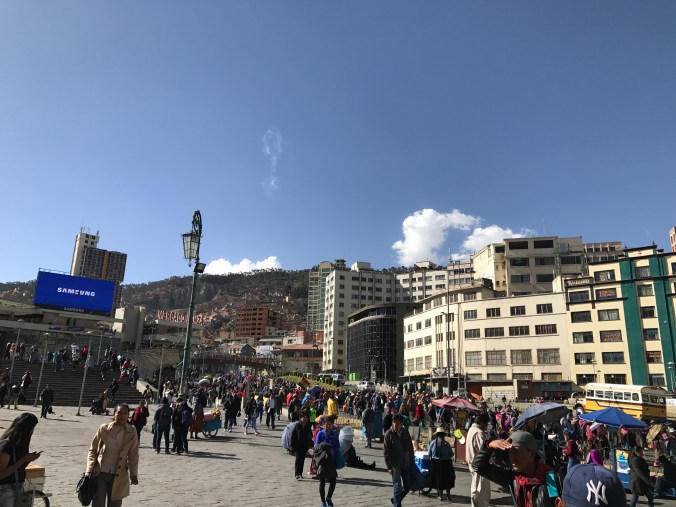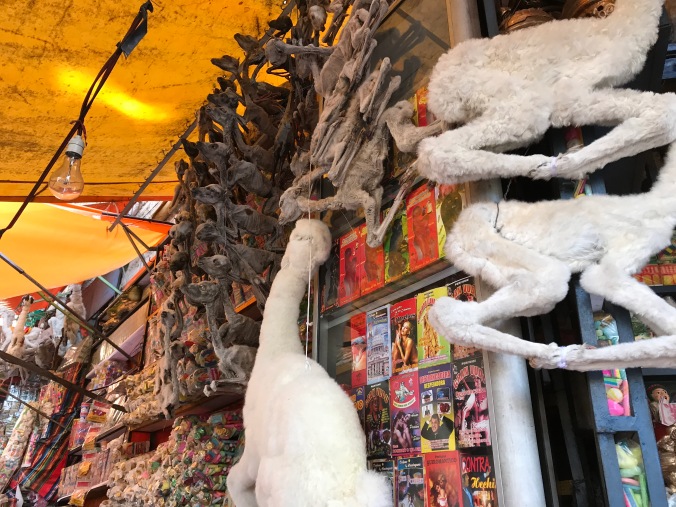The first thing you notice about La Paz when you’re flying into the city is that it’s super flat. Well, that’s what I thought until I got into the taxi and made my way into the city proper – it’s like this metropolis has been built into a gigantic crater rim!
It’s actually something that took my breath away. I mean, here you are expecting this flat, dry, hot (cold at night), dusty city (La Paz is all of those things, except flat), and the next thing you’re descending these ridiculously steep roads where buildings are virtually hanging off cliff faces. It’s something to see! No wonder public transport here is massively supported with cable cars.

Not the best photo from the taxi window.
The next thing you’ll notice about La Paz (and this seems to be a common thread around Bolivia) is that all the buildings look mostly the same – it’s as if there was a memo circulated saying all houses need to be constructed of un-plastered terracotta brick, with a silver corrugated iron roof. The occasional plastered wall will always be painted red, yellow or orange and will have the logo of a mobile network or beer company artistically drawn onto it. Viewing these homogenous buildings in their masses stuck onto steep slopes reminds me of those movie scenes set in the desert where an army steps into an ancient city for the first time.

Downtown La Paz.
For me, La Paz is totally different to the other big South American cities I’ve come across so far. Although it isn’t the capital of Bolivia, you can’t help but want to compare it to Bogota, Quito and Lima but I soon realized you can’t. These other cities feel like big cities and although there is a cultural centre, I always felt that there wasn’t much more going on (I’m generalizing for the sake of my argument, bear with me before you say I’m being unfair in my assessment). With La Paz, there is a languid air about it (once you cut away some of the worst traffic I’ve seen). No one is in a rush, the older generation are firmly entrenched in their customs (which are clearly being abandoned by the younger generation) but more importantly for me, I get the distinct impression the people are trying their best to shake their dodgy political reputation and trying to make something out of the city whilst holding onto a level of tradition.
The city has a few quirks which I need to mention:
The Witches Market: There is an active community of witches in La Paz and they can be found in the Witches Market. I first encountered the market on a free walking tour (which isn’t free…) and I couldn’t tear my eyes away from some of the witches crafts. The story goes that most of the witches do good stuff and lots of their business stems from home builders wanting to bless the site of their new houses by making a sacrifice to Pachamama (mother earth). Doing this entails buying a range of supplies, including a Llama foetus (yes, you read that right). I feel the tour guide may be bullshitting me, but he also spoke of human sacrifice at the building sites of major construction projects. All of this happens on the down-low. I’m suspicious as to how accurate this is… The witches also sell various potions to assist with daily domestic problems. Love and the falling out thereof is big business.

Llama foetuses in the Witches Market in La Paz.
San Pedro Prison: This prison, located in central La Paz, doesn’t have any guards on the inside! There are just a few guards on the outside that make sure none of the prisoners escape. The prison is notorious for some bad eggs – mostly drug dealers and manufacturers, along with your usual murderers and rapists. In a nutshell, once you are sentenced to prison, the prisoner then needs to pay a particular criminal gang within the prison – this affords a degree of protection along with a job (read: drug manufacturing). If you can’t afford the buy in, you’re effectively become the menial labor within the prison.
At one point, prison tours were allowed (run by the prisoners themselves but the tour really was window dressing to be able to sell cocaine to tourists). The tours came to a halt when a tourist was kidnapped and raped in the prison. You can’t make this stuff up!
To finish this post off, La Paz is the perfect city is get stuck into the nitty gritty of big city Bolivian life and experience its quirks. When I wasn’t doing this, I was chilling in one of the most amazing coffee shops I’ve been in – HB Bronze – you definitely need to add this as a stop in your planning!

HB Bronze – a pre-birthday treat!
From La Paz, I caught an overnight bus to Sucre, the capital of Bolivia. Being on time for the bus is no easy feat as it meant negotiating La Paz’s rush hour traffic – something I wouldn’t wish on my worst enemy! Hell, the traffic was so bad that my taxi driver stopped the car and said I better walk or I’ll miss the bus. Nothing like a 3km walk uphill in traffic, with a full backpack to make you wish you could afford a helicopter.
All I remember from the bus ride was that it was really comfortable by South American standards, I wasn’t freezing to death or fearing for my life and most importantly, time passes by so quickly whilst star gazing from your bus window – as soon as you leave the dust of the big city behind, the skies are crystal clear, this really makes me excited for the Atacama Desert in a few weeks time!
Sucre is on the tourist map as an ideal place to spend a few weeks learning Spanish. I don’t have the patience or inclination to do that to myself and choose to bastardise my way through the continent with my Spanglish.

I liked Sucre a lot as it is so quintessentially Bolivian. It is laid back, has an incredible central plaza and to top it all off, has some amazing restaurants to try out. I also like it as so many of the older women fully embrace their culture by wearing bowler hats and walk around town with gigantic fabric bags strapped to their backs!

A refreshingly green plaza in the middle of Sucre.
That’s all for now folks, hope you’re keeping well!